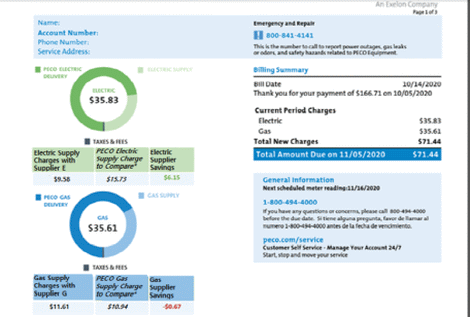|
|
|
|
|
PECO Proposes Placing Shadow Billing Chart On First Page Of Shopping Customer Bills; Including Amount Of Negative Savings
The following story is brought free of charge to readers by VertexOne, the exclusive EDI provider of EnergyChoiceMatters.com
Under a newly proposed electricity default service plan filed with the Pennsylvania PUC, PECO is proposing to add a chart to the first page of the residential customer bill that
compares the customer’s total retail supplier charges for the billing period and what the dollar amount
of the charges would have been under PECO’s applicable price to compare (PTC) based on the customer’s usage during the
billing period.
In addition to showing the monthly cost amounts under both competitive retail supply and the shadow-billed default service, the bill would calculate and list in a column the savings, or negative savings as applicable, under retail supplier service
In listing the PECO supply charges, the chart's heading invites use of the PECO supply charges, "to compare"
A mock bill showing the proposed changes indicates that PECO proposes to implement the shadow billing chart for both electricity and natural gas
See an example of the proposed shadow billing comparison chart below (click image for larger example, or click here)
PECO notes that it uses bill ready billing and thus proposed the total bill comparison chart, rather than listing the supplier's rate versus the PTC since PECO does not have supplier rate information in its system
Reserve Price
As noted above, PECO is proposing the bill format change as part of a new default service plan (“DSP VI”), which is proposed to cover the period June 1, 2025 through May 31, 2029
The other most notable change proposed under the new DSP is the use of a reserve price for residential customer fixed price full requirements (FPFR) supply procurements
The reserve price would, "help protect customers from paying high prices for FPFR products that
could be considered outside of a reasonable market range," PECO said
"The incorporation of the reserve price mitigates the possibility that residential
customers will pay FPFR product prices that exceed the level that they may be
willing to pay for the benefits of FPFR products. This will further ensure that
customers are provided generation supply at the least cost," a witness for PECO said
The reserve price for a residential product is the average bid price above which
the Independent Evaluator would recommend that the Commission reject the
lowest-priced bids that caused the average bid price to exceed the reserve price.
A witness for PECO said, "The reserve price aims to provide protection to residential customers from prices
that may exceed the level they may be willing to pay for the benefits of fixed
price full requirements products in cases where bids on average appear outside of
a reasonable range given then-current market conditions. Of course, the
Commission has the final say on whether to approve or reject each of the lowest
priced bids."
PECO said that the reserve
price for each residential FPFR product (12-month and 24-month delivery
periods) will be determined by the Independent Evaluator to account for the costs
and risks of the FPFR product obligation. The reserve price will be finalized on
the date that bids are due to account for the most up-to-date forward energy prices and other market data relevant to the PECO PJM zone, PECO said
The Independent
Evaluator will not announce the reserve price for a product to bidders.
However,
the reserve price will be reported to the Commission by the Independent
Evaluator along with the RFP results.
Other Default Service Plan Provisions
Generally speaking, aside from the two changes noted above, PECO's new default service plan proposes to continue the design and provisions of the current plan, except for the following additional changes:
• PECO is proposing to double
the amount of solar AECs procured through long-term (10-year) purchase agreements during the
DSP VI term, from 16,000 solar AECs to 32,000 solar AECs
• PECO is proposing to incorporate a Capacity Proxy Price (“CPP”)
mechanism into the Company’s Supplier Master Agreement (“SMA”) for use when a PJM BRA capacity price is not known at the time of a default service procurement
• PECO is proposing to increase the wholesale supplier load cap for the Large Commercial and Industrial Class from 50% to 75%
For DSP VI, PECO is proposing to maintain the same
procurement groups (customer size cut-offs)
In DSP VI, PECO proposes to maintain the same rate design approved by the
Commission in DSP V, including the current TOU rate options for eligible Residential and Small
Commercial default service customers
PECO proposes to maintain the procurement strategy established in prior default
service programs, which generally utilizes full requirements (aside from certain AECs), load-following products, and short periods
between the solicitation and delivery of supply products.
For the Residential Class, under DSP VI, PECO proposes to continue to procure a
mix of one-year (approximately 38%) and two-year (approximately 61%) FPFR, load-following
products. The remaining Residential Class load will be supplied directly by PJM’s spot energy,
capacity and ancillary service markets (approximately 1%).
As in DSP V, each of the
Residential Class products will be procured approximately two months prior to the beginning of
the applicable delivery period.
PECO proposes to continue to serve the Small Commercial class with equal
shares of one-year and two-year FPFR products procured approximately two months prior to delivery of the energy.
Large C&I customers would continue to receive hourly pricing
Concerning the capacity proxy price (CPP), the CPP would be calculated as the average of the
most recent results under PJM’s RPM from the two most recent delivery years for which PJM
has held a capacity auction. Commencing at the start of the delivery year for which the BRA
results were not known, winning suppliers will be debited or credited (as applicable) any
differences between the CPP and the actual PJM capacity price.
PECO proposes to continue offering its existing Standard Offer Program from
June 1, 2025 through May 31, 2029. Consistent with PECO’s current tariff, the Company
proposes to continue to recover Standard Offer Program costs through an EGS participant fee of
$30 per enrolled customer, with any remaining costs recovered in the following manner: (1)
50% from EGSs through a Purchase of Receivables discount; and (2) 50% from residential and
small commercial default service customers via the GSA.
Docket Number P-2024-3046008
ADVERTISEMENT ADVERTISEMENT Copyright 2010-23 Energy Choice Matters. If you wish to share this story, please
email or post the website link; unauthorized copying, retransmission, or republication
prohibited.
PECO Also Proposing Residential Reserve Price In Procurements To Ensure SOS Customers Pay "Least Cost"
February 6, 2024
Email This Story
Copyright 2010-23 EnergyChoiceMatters.com
Reporting by Paul Ring • ring@energychoicematters.com


NEW Jobs on RetailEnergyJobs.com:
• NEW! -- Customer Care Specialist I & II- remote/hybrid -- Retail Supplier
• NEW! -- Pricing Analyst - Retail Power
• NEW! -- Electricity Pricing Analyst
-- Retail Supplier
• Business Development Manager -- Retail Supplier
• Call Center Manager -- Retail Supplier
|
|
|
|









